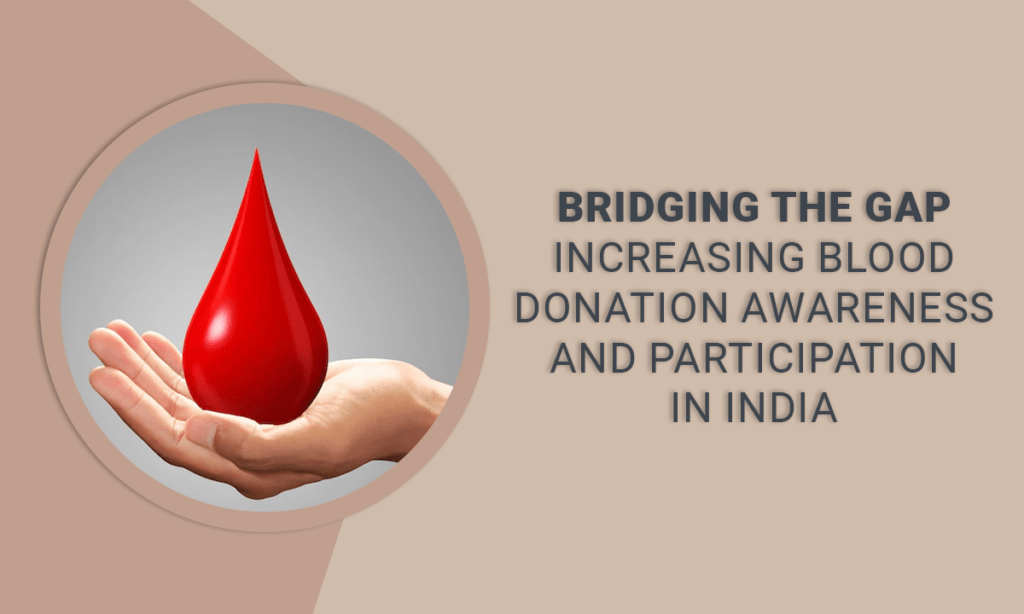In India, a country that rides high on community and kinship, the act of blood donation is a testament to its collective spirit. Despite this, the nation faces a significant gap between the need for and supply of blood. Bridging this gap is not just a matter of increasing the number of blood donation camps but also about enhancing awareness and participation in these life-saving endeavors.
This blog post aims to explore the avenues through which India can bolster blood donation awareness and participation, ensuring that every individual in need has access to this crucial resource.
The Current Landscape of Blood Donation in India
India’s requirement for blood is vast, with the nation’s burgeoning population and high prevalence of medical conditions necessitating blood transfusions. The challenge is amplified by a lack of awareness and persistent myths surrounding blood donation. The National Blood Transfusion Council (NBTC) and other such bodies work tirelessly to ensure blood availability, yet the demand often outstrips supply.
Understanding the current landscape is the first step toward change. It involves recognizing the hurdles in donor recruitment, retention, and the logistical challenges that blood banks face. Addressing these issues requires a multi-faceted approach, combining education, motivation, and community engagement.
Cultivating Awareness: Education as a Tool
Ignorance is often cited as a primary barrier to blood donation. Dispelling myths and educating the populace is crucial.
Educational Campaigns
Launching comprehensive educational campaigns across various media can significantly impact awareness levels. These campaigns should aim to inform the public about the need for blood, the simplicity of the donation process, and the health benefits it entails for donors.
Inclusion in Academic Curriculum
Integrating blood donation education into the academic curriculum can instill the importance of this act from a young age. Educational institutions can play a pivotal role by organizing regular blood donation drives and seminars.
Leveraging Celebrity Influence
Celebrities and public figures command significant influence in India. Their endorsement of blood donation can inspire fans and followers to take action and contribute to this noble cause.
Mobilizing the Masses: Community Engagement and Incentivization
To convert awareness into action, it is essential to engage with communities at a grassroots level.
Community Drives
Organizing community-specific blood donation drives can tap into the collective ethos of Indian society. Tailoring these drives to cater to local festivals, fairs, and markets can integrate blood donation into the fabric of community life.
Recognizing Donors
Recognizing blood donors through awards and certificates can provide a sense of achievement and encourage repeat donations. Public acknowledgment in local assemblies or social media can also serve as a powerful motivator.
Corporate and Institutional Involvement
Encouraging corporate entities to include blood donation in their Corporate Social Responsibility (CSR) initiatives can lead to a structured and sustained donation framework. Institutions can also adopt blood donation as a part of their regular welfare activities.
Overcoming Myths and Fears: A Targeted Approach
Myths and fears surrounding blood donation can be deep-rooted and varied across different sections of society.
Addressing Myths
Specific campaigns designed to address common myths and fears about blood donation, such as weakness, illness, or weight gain, can be effective. These should include testimonials from regular donors and medical professionals.
Creating a Safe Environment
Ensuring that blood donation camps are safe, hygienic, and run by trained professionals can alleviate fears related to the donation process. Transparency in procedures and providing donors with clear post-donation guidelines can build trust.
Personal Stories
Sharing personal stories of individuals whose lives have been saved through blood donations can be a powerful way to convey the importance of giving blood. It puts a human face on the beneficiaries of donation, making the need for blood more relatable.
Strengthening Infrastructure: The Backbone of Effective Donation
Without the proper infrastructure, even the most aware and willing donors cannot contribute effectively.
Mobile Donation Units
Investing in mobile blood donation units can take the donation process to remote and underserved areas, making it convenient for potential donors to contribute without traveling long distances.
Streamlining Donation Processes
Simplifying the registration and donation process, reducing wait times, and ensuring donor comfort can enhance the donation experience, making donors more likely to return.
Robust Blood Bank Networks
Developing a robust network of blood banks and ensuring they are equipped to handle the storage and distribution of blood can reassure donors that their contributions are being used effectively and efficiently.
Conclusion: A Call to Collective Action
The journey to increasing blood donation awareness and participation in India is a collective endeavor. It requires the concerted efforts of government bodies, non-profits, healthcare providers, educational institutions, corporates, and, most importantly, the citizens themselves. By educating, engaging, and empowering the Indian populace, we can transform the act of blood donation from a mere civic duty to a shared cultural norm.
As we continue to navigate through the complexities of healthcare in India, let’s remember that each pint of blood has the power to save lives. It’s a gift of life that one can give, and it epitomizes the very essence of humanity — compassion and solidarity. So let’s pledge to bridge the gap, one donation at a time, and ensure that for every person in need, blood is available, because every drop counts, and every donor matters.
People Also Read: Breaking Free: Personal Journeys of Recovery from Substance Abuse in India
